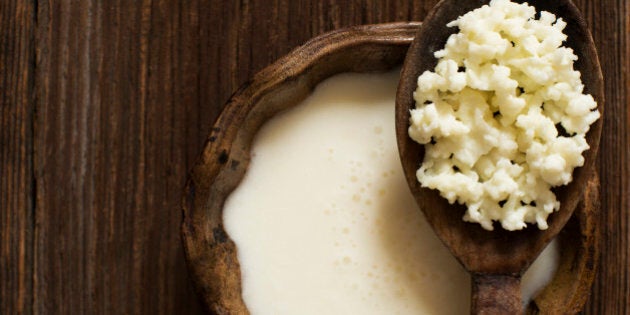
If you've been in a grocery store or a farmer's market, you've no doubt seen kefir. The product is a fermented drink made usually with milk or juice. It has been around for thousands of years and is imbibed worldwide. As the name, which is an ancient word for "good feelings", implies, the concoction provides a welcome effect on the tongue and the body.
The process of making kefir is a long-standing tradition. A series of congealed sugars and microbial biofilms, known as grains, are introduced into a liquid and then allowed to ferment. Depending on the type of grain, several species of bacteria -- and at times yeast -- gobble up the sugars and produce a variety of byproducts, usually acids. These in turn tickle the tongue and not long after, provide a biological effect in the body. Depending on the species used, the benefits can range from antioxidant activity to immune balance and in some cases, prevention of tumours.
Yet, while these benefits continue to be discovered, there is a caveat. The microbiological composition of kefir grains differs around the world meaning no two are going to provide the same benefits. This could lead to incorrect assumptions of the positive effects on health.
There are ways, however, to get past this hurdle. The most convincing way to know the benefits of each kefir type is to undergo clinical trials. However, these are relatively expensive and for many kefir aficionados, be outside of their price range.
The other is to identify the species inside the grains and figure out the byproducts they produce. Many of these chemicals have already proven their benefits in other studies both in the lab and in clinical trials. If the molecules are present in the liquid, there's a good chance the associated effects may be seen.
Last week, a group of Irish researchers performed the latter task. Using kefirs collected from around Europe, they identified the microbes present and the chemicals produced by individual species. The results showed the incredible complexity of kefir and more importantly, why these drinks are so beneficial and enjoyable.
For this study, three kefirs were chosen. One was from France, another from the United Kingdom and a third from Ireland. The team first allowed the kefirs to ferment over 24 hours so the microbial populations could grow and produce those beneficial chemicals. At different intervals, both the bacteria and the chemicals were identified in the lab. The goal was to link up various chemicals with their microbial producers.
When the results came back, the researchers were given a bit of a surprise. They expected a rather high diversity in the kefir over the 24 hour period. Yet, this rather large variety was only stable for a few hours. As time went on, a few species seemed to gain control of the environment and essentially took over.
Of the dominating species, most were associated with fermentation. Names such as Leuconostoc, Acetobacter, and Kazachstania were seen as the major players. Some of the species identified at the beginning were known to be probiotic in nature, such as Lactobacillus helveticus. Yet their numbers fell significantly by the end of the experiment.
This rather eclectic mix of microbes suggested the byproducts would not be the same as those found in other healthy fermented foods, such as yogurt. When the chemical analyses were performed, 39 different compounds known to provide aroma and flavour were identified. Most were associated with buttery and sweet flavours although some were known to provide fruity notes.
The real surprise came from the lack of major chemical changes between the three samples. Of the 39 chemicals, only a few differed greatly between the three samples. Yet, in taste tests, the authors confirmed these small changes were enough to give each concoction a different nose and flavour.
As for those benefit-based molecules, only one showed up in any significant concentration: acetic acid, which is usually found in vinegar. This particular chemical is known to play a role in human health by helping to balance both human and microbial metabolic processes. As for the source of this particular chemical, the team found it was due to the aptly named Acetobacter species.
The results of this study reveal the rather complex nature of kefir and also how small changes can make a large different in both taste and smell. The information also shows the potential for health benefit although at least in these three cases, those positive effects may be due to a single molecule. Even so, there's little doubt kefir is both enjoyable both on the outside and also on the inside.
If you are interested in picking up some kefir, you should be aware of one note of caution. Some products attempt to sweeten the taste by adding close to two tablespoons of sugar for each serving. This amount would be less than a can of soda pop yet would still surpass what the World Health Organization suggests should be taken in each day. To be sure you are getting the most benefit, keep an eye on the label and make sure those sugar levels are low.
Follow HuffPost Canada Blogs on Facebook